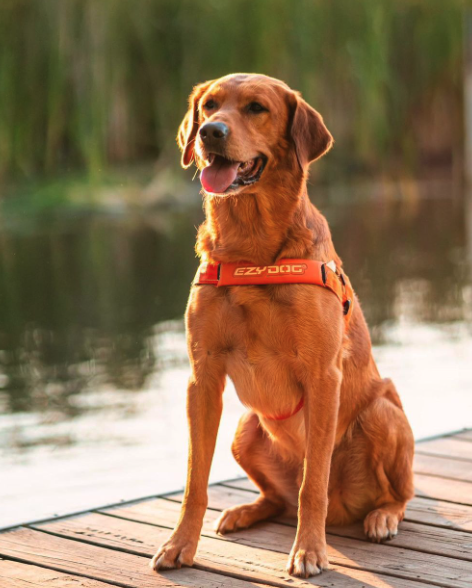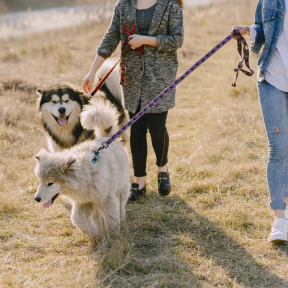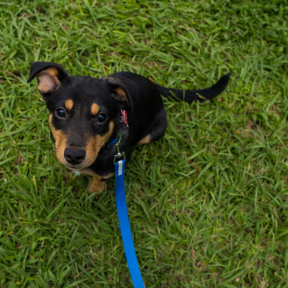How to Put on a Dog Harness
31st Oct 2022
A harness is a great way to control your dog better while walking, but some dog owners are hesitant to move from a regular collar. After all, harnesses tend to look intimidating with all the straps and buckles, but don’t let looks fool you.
The truth is, they are pretty easy to put on and use, and a great training tool, especially for dogs that tend to pull. A well-fitted harness can really make a difference in the quality of your walks with your dog.
It starts with having the right harness and knowing how to put it on. Our step-by-step guide will get you up to speed in no time.
How to Measure for a Dog Harness
When measuring your dog for a harness, the most important measurement is the strap that goes around the body.
To measure your dog for a good harness fit:
- Get your dog to stand as still as possible.
- Slip the tape measure around the dog’s torso, just behind the front legs and over the shoulder blades.
- When you get the harness, slip it on the dog and check that it fits well. You can do this by slipping two fingers under the strap around the torso and the strap across the chest that acts as the neck hole. These are the two points that are most prone to rubbing and binding.
Many harnesses have adjustable straps so you can tighten or loosen them to get a better fit. Check the adjustment points each time you alter the fit until you are satisfied that it fits well. If you can’t seem to get the fit right, you may need to get another size or even a different style.
How to Put on a Dog Harness
Fitting your harness depends on the type of harness. You and your pup can easily slip on the harness with practice. The key is to make it a fun experience for your dog, so it’s something they look forward to.
Step-In Harness
A step-in dog harness fastens at the back and is a great option for a nervous, anxious dog that doesn’t like having a harness put over their head. And a great escape proof option if your dog is an escape artist.
How to put a step-in harness on your dog.
- Lay the harness on the ground in front of you so that the strap that goes around the body is closest to you and the strap that goes around the dog’s chest is farthest away. It should lie flat so that you see the two triangles where the dog’s feet will go. The D-rings should be under the buckles.
- Grasp your dog’s torso while behind them. Gently position the dog so that each front foot is in a triangle. The middle strap should run between the dog’s front legs.
- Pick up the ends of the harness on either side and bring them together over the dog’s shoulders. Secure the clasps at your dog’s back.
- Adjust the harness for a secure but comfortable fit. You should not be able to pull the harness over your dog’s head, but it should not bind anywhere.
Overhead Harness
Overhead harness slips over the dog’s head, and the body strap goes around the dog’s body, fitting just behind the front legs. This type of harness is also good for dogs that like to wriggle out of their collars but not so great for nervous nellies that don’t like things going over their heads.
- Give the command to sit. It is possible to put the harness on while the dog is standing but it is usually easier to put it on while they are sitting. That way, if you struggle with a buckle or clasp your dog is in a comfortable position instead of standing for a long time. They are also less likely to be distracted and bolt from a sitting position because you can stop them before anything happens.
- Slip the neck hole over the dog’s head and guide the harness over the torso so the straps hang on either side of the dog’s body. Bring the ends of the straps together under the dog’s body so that the clip sections meet.
- Secure the harness by buckling or clipping the straps.
- Make any necessary adjustments to the fit by checking to make sure the straps aren’t too loose or aren’t binding anywhere. You want to checkpoints around the dog’s shoulder blades, chest, neck, and legs. A good fit will prevent your dog from getting out of the harness, which means a more pleasant walk for both of you.
How to Attach Leash to Harness
Once you have the harness in place, it’s time to attach the leash. All harnesses will have at least one leash clip and a metal ring for the leash attachment. On some dog harness styles, this will be on the back, at the belly strap, while others will be on the chest strap. Several harness styles have a D ring at both points.
A front leash attachment is good for small dogs, especially those with delicate throats because it takes the pressure off the dog’s neck. It is also good as a training harness for dogs that are learning not to pull on a leash.
Having the leash clip on the back is good for dogs that aren’t prone to pulling, are calmer, or have a little moreleash training.
- Locate the D ring on the harness. The metal ring serves as a leash attachment and is on the back or front of the harness. If you have a harness with dual attachments, decide which one you want to use before you begin to attach the leash. If you are training, start with a front clip harness because it gives you better control.
- If your dog is nervous, you may need to get in front of them and get down to their level to reduce their anxiety. If they have never had a leash, you can show it to them while talking softly.
- Gently click the leash onto the attachment while firmly holding the hand strap in case the dog decides to bolt.
- Praise your dog for sitting still and cooperating. If you use treats for rewards, now is the time to pass them out. You want your dog to associate the harness and leash with positive feelings.
10 Tips for Putting a Pet Harness on Your Dog

Wearing a harness and walking on a leash are skills your dog must learn. Some dogs aren’t very receptive to the idea of wearing a harness and they can make the process difficult. This can come from inexperience, age, or a bad experience with a harness. Whatever the case, these tips will help you make the harness a better experience for your dog.
- Pour on the praise. At each step of the process, give your dog praise through your words, lots of pets, and the occasional treat if you use that as a training method. You want your dog to associate the experience with good, happy, positive feelings.
- Be gentle, don’t tug, pull, or jerk. Being rough with your dog while putting on the harness can cause them to associate it with negative feelings.
- Decide on a position for putting on the harness and stick to it. Sitting is usually the best position for putting on a harness, although some dog owners prefer to have the dog standing. Ultimately, it is up to you.
- Create a routine. Dogs like structure. Teach your dog that when you use certain terms such as “walk,” they are to sit quietly and let you put the harness on them and attach the leash. Do it the same way every time, so they know what to expect.
- Stay calm. A harsh tone or yelling won’t make your dog behave, it will only make them react in fear. That is something you don’t want and certainly not the experience you want them to have with putting on the harness and going for a walk.
- Attach the leash before putting on the harness if the dog is overly anxious or is afraid of the leash. Until your dog is used to the leash, you may want to attach it beforehand until they are used to it.
- Always check the fit. Harness straps can shift and a dog’s weight can fluctuate. Check the fit every time you put on the harness.
- Get the dog used to the harness before you put it on them. Start with putting the harness on the floor and letting the dog sniff it. Put it on and let the dog walk around the house while wearing the harness so they can get used to it.
- Give consistent commands and talk to your dog while putting on the harness and leash to keep the dog calm and focused on you so that you can maintain better control.
- Have patience. Puppies and older dogs can struggle getting used to a harness. Be patient and give them the time, flexibility, and love to let them learn. They just want to please you.
The best harness is the one that works best for both you and your dog. EzyDog carries acomplete line of dog harnesses in a variety of styles and sizes.
Shop our online store today and get the top brands for training, travel, recreation, and so much more. Your dog deserves the best; at EzyDog, that’s exactly what you’ll get.






